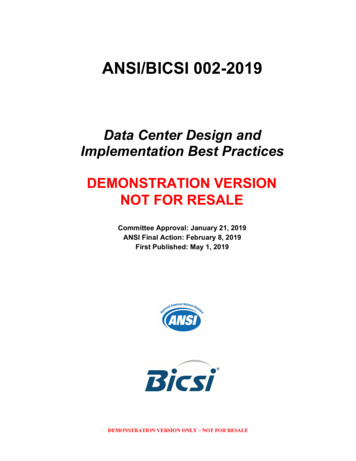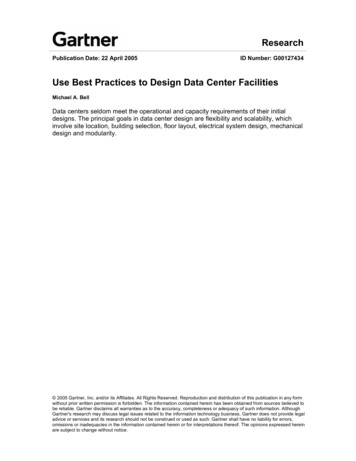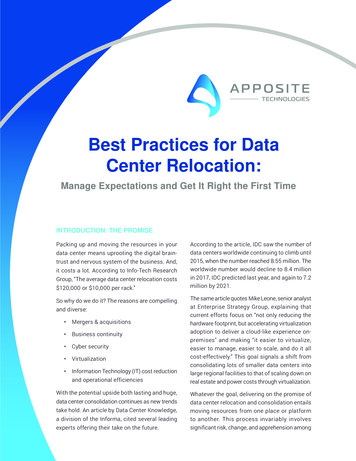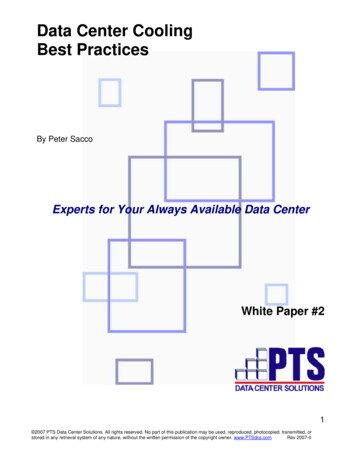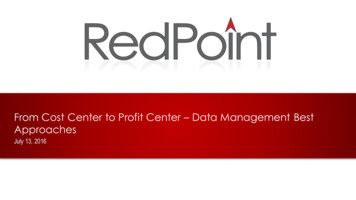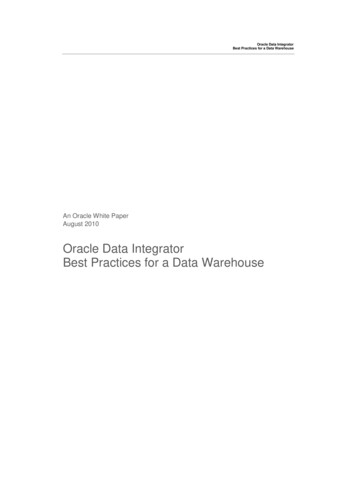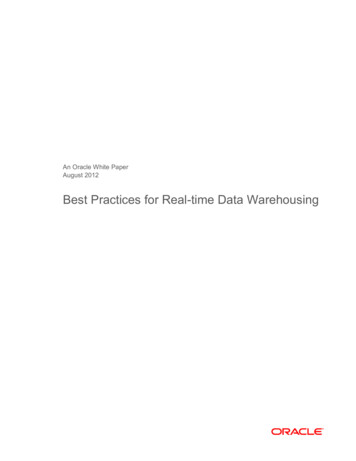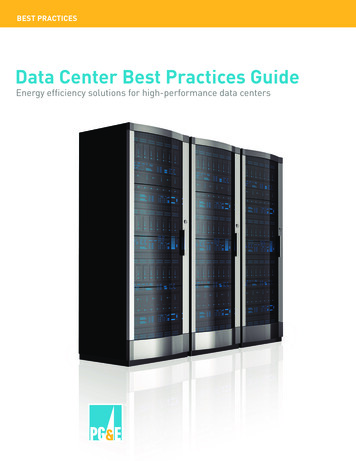
Transcription
BEST PRACTICESData Center Best Practices GuideEnergy efficiency solutions for high-performance data centers
Table of ContentsIntroduction.11. Information Technology (IT) Systems .32. Air Management .103. Air-Side Economizer .194. Centralized Air Handling .265. Cooling Plant Optimization .346. Direct Liquid Cooling .427. Free Cooling via Water-Side Economizer.498. Operational Parameters .559. On-Site Generation .6410. Uninterruptible Power Supply Systems .6811. Dynamic Response .76i
iiData Center Design Guidelines
Introduction Data centers can consume 100 to 200 times as much electricity as standardoffice spaces. With such large power consumption, they are prime targets forenergy efficient design measures that can save money and reduce electricity use.However, the critical nature of data center loads elevates many design criteria-- chiefly reliability and high power density capacity – far above efficiency. Shortdesign cycles often leave little time to fully assess efficient design opportunitiesor consider first cost versus life cycle cost issues. This can lead to designs thatare simply scaled up versions of standard office space approaches or that reuse strategies and specifications that worked “good enough” in the past withoutregard for energy performance. This Data Center Best Practices Guide hasbeen created to provide viable alternatives to inefficient data center design andoperating practices and address energy efficiency retrofit opportunities.Based upon benchmark measurements of operating data centers and input frompracticing designers and operators, the design guidelines are intended to providea set of efficient baseline design approaches for data center systems. In manycases, the design guidelines can also be used to identify cost-effective savingopportunities in operating facilities. No design guide can offer ‘the one correctway’ to design a data center, but the design guidelines offer efficient designsuggestions that provide efficiency benefits in a wide variety of data center designsituations. In some areas, promising technologies are also identified for possiblefuture design consideration.From the level of the data center owners and tenants, to the designers andequipment manufacturers, there are many key players involved when forming anew or retrofitting an old data center. A careful collaboration between all datacenter stakeholders is essential for establishing persistent energy efficient datacenter operation.Data center design is a relatively new field that houses a dynamic and evolvingtechnology. The most efficient and effective data center designs use relativelynew design fundamentals to create the required high energy density, highreliability environment. The following best practices capture many of the new‘standard’ approaches used as a starting point by successful and efficient datacenters.Introduction1
2Data Center Design Guidelines
1. Information Technology (IT) SystemsIn a typical data center with a moderately efficient cooling system, IT equipmentloads can account for over half of the entire facility’s energy use. Use of efficientIT equipment will significantly reduce these loads within the data center, whichconsequently will downsize the equipment needed to cool them. For a data centerwith typical infrastructure efficiency, saving one Watt of server power can savemore than 15 over a three year server lifespan; assuming infrastructure costsof 6.00 /Watt and an annual average electric rate of 0.14 per kWh. Purchasingservers equipped with energy-efficient processors, fans, and power supplies,high-efficiency network equipment, consolidating storage devices, andimplementing virtualization are the most advantageous ways to reduce ITequipment loads within a data center.Efficient power supplies usually have a minimal incremental cost at the serverlevel; however, management intervention may be required to encourageequipment purchasers to select efficient models. The purchasers need to begiven a stake in reducing operating cost and the first cost of the electrical andconditioning infrastructure, or at least be made aware of these costs, in orderto make a rational selection. The impact of real operating loads should also beconsidered to select power supplies that offer the best efficiency at the load levelat which they are expected to most frequently operate.Principles Specify and utilize high efficiency power supplies in Information Technology(IT) computing equipment. High efficiency supplies are commerciallyavailable and will pay for themselves in very short timeframes when thetotal cost of ownership is evaluated. Inactive servers can use 50% or more of full computational power.Consolidation measures such as server virtualization increase serverutilization factors and therefore increase server computational efficiency. For a modern, heavily loaded installation with 100 racks, use of highefficiency power supplies alone could save 270,000- 570,0001 per yearand decrease the square-footage required for the IT equipment by allowingmore servers to be packed into a single rack footprint before encounteringheat dissipation limits.Part 1: Information Technology (IT) Systems3
Cooling load and redundant power requirements related to IT equipment canbe reduced by over 10 – 20%, allowing more computing equipment densitywithout additional support equipment (UPS, cooling, generators, etc.). In new construction, downsizing of the mechanical cooling equipment and/orelectrical supply can significantly reduce first cost and lower the mechanicaland electrical footprint. When ordering servers, specify power supplies that meet at least the minimumefficiency recommendations by the Energy Star and 80 PLUS. Energy Starrated servers are 30% more efficient than standard servers, on average. When appropriate, limit power supply oversizing to ensure higher – and moreefficient – load factors.ApproachThe individuals specifying data center equipment should consider the efficiency ofthis equipment. Frequently, there is little connection between the group selectingdata center equipment and the group that is aware of (and responsible for paying) theequipment’s energy costs. Often, the department that selects and procures the datacenter equipment deals with hardware and software deployment issues and has littleif any interaction with the department responsible for paying operating costs. Withno feedback regarding operating cost, energy efficiency is often overlooked by theselectors – unless, perhaps, they have had negative, usually expensive, experiencewith overheating racks and the associated risk of equipment failure.To encourage the use of more efficient servers, storage devices, network equipmentand power supplies, an organization must illustrate the clear connection betweenequipment energy usage and operating cost to the people who make the equipmentpurchasing decisions. With many types of equipment becoming commodity items andwith small differences in price heavily impacting the selection, it is essential that thetotal cost of ownership of low efficiency IT equipment be recognized in the selectionprocess.A simple management approach to address the disconnect between equipmentpurchases and the resulting energy bills and extra first-cost for facility infrastructurewould be to offer an internal budget incentive equal to one to three years of energysavings for the purchase of equipment meeting the high efficiency performance level.For example, when purchasing servers that consume 200 watts, the purchaser’sbudget would be increased by 70- 150 per server if the server exceeds minimumefficiency standards set forth by the US EPA’s Energy Star program. The ‘incentive’money would be recovered from the reduced operating cost. Such a system provides4Data Center Design Guidelines
much needed feedback between the equipment purchases (and by extension,manufacturers) and the total cost of ownership by allowing equipment purchasesto be quickly and rationally evaluated on their true cost. The opportunity for energysavings from using high efficiency power supplies in a data center can be investigatedusing the simplified calculation tools developed as part of the LBNL project on datacenters (see http://hightech.lbl.gov/server-ps-tool.html). Further internal incentivescan be rewarded for implementing measures such as server virtualization whichreduce the IT equipment in the data center.Efficient ServersRack servers tend to be the main perpetrators of wasting energy and represent thelargest portion of the IT energy load in a typical data center. Servers take up most ofthe space and drive the entire operation. The majority of older servers run at or below20% utilization most of the time, yet still draw full power during the process. Recentimprovements in the internal cooling systems and processor devices of servers havebeen made to minimize this wasted energy.When purchasing new servers it is recommended to look for products that includevariable speed fans as opposed to a standard constant speed fan for the internalcooling component. With variable speed fans it is possible to deliver sufficient coolingwhile running slower, thus consuming less energy. The Energy Star program aidsconsumers by recognizing high-efficiency servers. Servers that meet Energy Starefficiency requirements will, on average, be 30% more efficient than standard servers.Multi-core processor chips allow simultaneous processing of multiple tasks, whichleads to higher efficiency in two ways. First, they offer improved performance withinthe same power and cooling load as compared to single-core processors. Second,they consolidate shared devices over a single processor core. Not all applications arecapable of taking advantage of multi-core processors. Graphics-intensive programsand high performance computing still require the higher clock-speed single-coredesigns.Further energy savings can be achieved by consolidating IT system redundancies.Consider one power supply per server rack instead of providing power supplies foreach server. For a given redundancy level, integrated rack mounted power supplieswill operate at a higher load factor (potentially 70%) compared to individual serverpower supplies (20% to 25%). This increase in power supply load factor vastlyimproves the power supply efficiency. Sharing other IT resources such as CentralProcessing Units (CPU), disk drives, and memory optimizes electrical usage as well.Short term load shifting combined with throttling resources up and down as demanddictates is another strategy for improving long term hardware energy efficiency.Part 1: Information Technology (IT) Systems5
Storage DevicesPower consumption is roughly linear to the number of storage modules used.Storage redundancy needs to be rationalized and right-sized to avoid rapid scale upin size and power consumption.Consolidating storage drives into a Network Attached Storage or Storage AreaNetwork are two options that take the data that does not need to be readilyaccessed and transports it offline. Taking superfluous data offline reducesthe amount of data in the production environment, as well as all the copies.Consequently, less storage and CPU requirements on the servers are needed,which directly corresponds to lower cooling and power needs in the data center.For data that cannot be taken offline, it is recommended to upgrade fromtraditional storage methods to thin provisioning. In traditional storage systems anapplication is allotted a fixed amount of anticipated storage capacity, which oftenresults in poor utilization rates and wasted energy. Thin provisioning technology,in contrast, is a method of maximizing storage capacity utilization by drawingfrom a common pool of purchased shared storage on an as-need basis, underthe assumption that not all users of the storage pool will need the entire spacesimultaneously. This also allows for extra physical capacity to be installed at a laterdate as the data approaches the capacity threshold.Data Deduplication is yet another method of improving storage utilization. In thededuplication process, redundant bits of data are eliminated, leaving only onecopy of data to be stored along with references to the unique copy of data. As aresult power, space, and cooling requirements are reduced. Data deduplication isparticularly effective when used with virtual servers.ConsolidationHardware LocationLower data center supply fan power and more efficient cooling systemperformance can be achieved when equipment with similar heat load densitiesand temperature requirements are grouped together. Isolating equipment byenvironmental requirements of temperature and humidity allow cooling systems tobe controlled to the least energy-intensive set points for each location.This concept can be expanded to data facilities in general. Consolidatingunderutilized data center spaces to a centralized location can ease theimplementation of data center efficiency measures by focusing them on onelocation, rather than several.6Data Center Design Guidelines
VirtualizationVirtualization is a method of ru
Data center design is a relatively new ield that houses a dynamic and evolving technology. The most eficient and effective data center designs use relatively new design fundamentals to create the required high energy density, high reliability environment. The following best practices capture many of the new ‘standard’ approaches used as a starting point by successful and eficient data .

